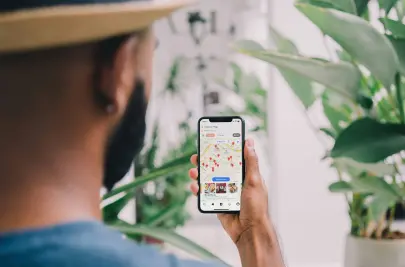Google Maps Route Planner: How To Plan Multi-Stop Routes

Need a route planner with multiple stops? Google Maps doesn’t make it easy, but it can be done. We’ll show you how to get from 10 to 25 stops in Google Maps, how to use Routific’s Chrome extension to automatically optimize your route, and how Google’s My Maps can expand your route planning possibilities.

- Google Maps route planner has a limit of 10 stops per route.
- You need to rearrange stops by hand to get the best route.
- You can increase your limit to 25 stops by using the free MoreThan10 tool.
- To get automatic route optimization of up to 25 stops, use Routific's free Chrome extension for Google Maps.
- Use Google’s My Maps to map up to 2,000 different places and create routes of up to 10 stops at a time.
- For businesses that need more powerful route planning and added delivery management features, consider route planning software like Routific. It’s free to try for seven days.
Google Maps is the world's favorite mapping and navigation app for a good reason. It's free, easy to use and reliable. But what if you need to do more than get from point A to point B, and plan a route with multiple stops? It might be for a road trip, for errands around town, or for a delivery route.
The good news: Google Maps lets you plan a route with up to 25 stops. The bad news: Google Maps was never designed to be a multi-stop route planner, so it’s a clunky and time-consuming process.
In this tutorial we’ll show you four Google Maps route planning tricks:
- How to use just Google Maps to plan a route with multiple addresses, up to 10 stops.
- How to add up to 25 stops to your Google Maps route.
- How to use Routific’s Chrome extension, using our route optimization algorithm, to turn Google Maps into a route planner.
- How to use Google’s My Maps for routes longer than 10-25 stops.
If you need to plan a delivery route, you’ll need a more advanced approach. You can try the steps in our Google Maps Route Planner for Deliveries article. But if you’re planning routes more than once a week or so, it will be easier to use delivery software like Routific.
💡Want to skip the manual work? Save hours of planning time with Routific — it’s free to try for seven days, with no stop limits.
A. How to use Google Maps as a multi-stop route planner
Here’s how to use Google Maps route planner to create a route with multiple stops.
1: Add your first stop
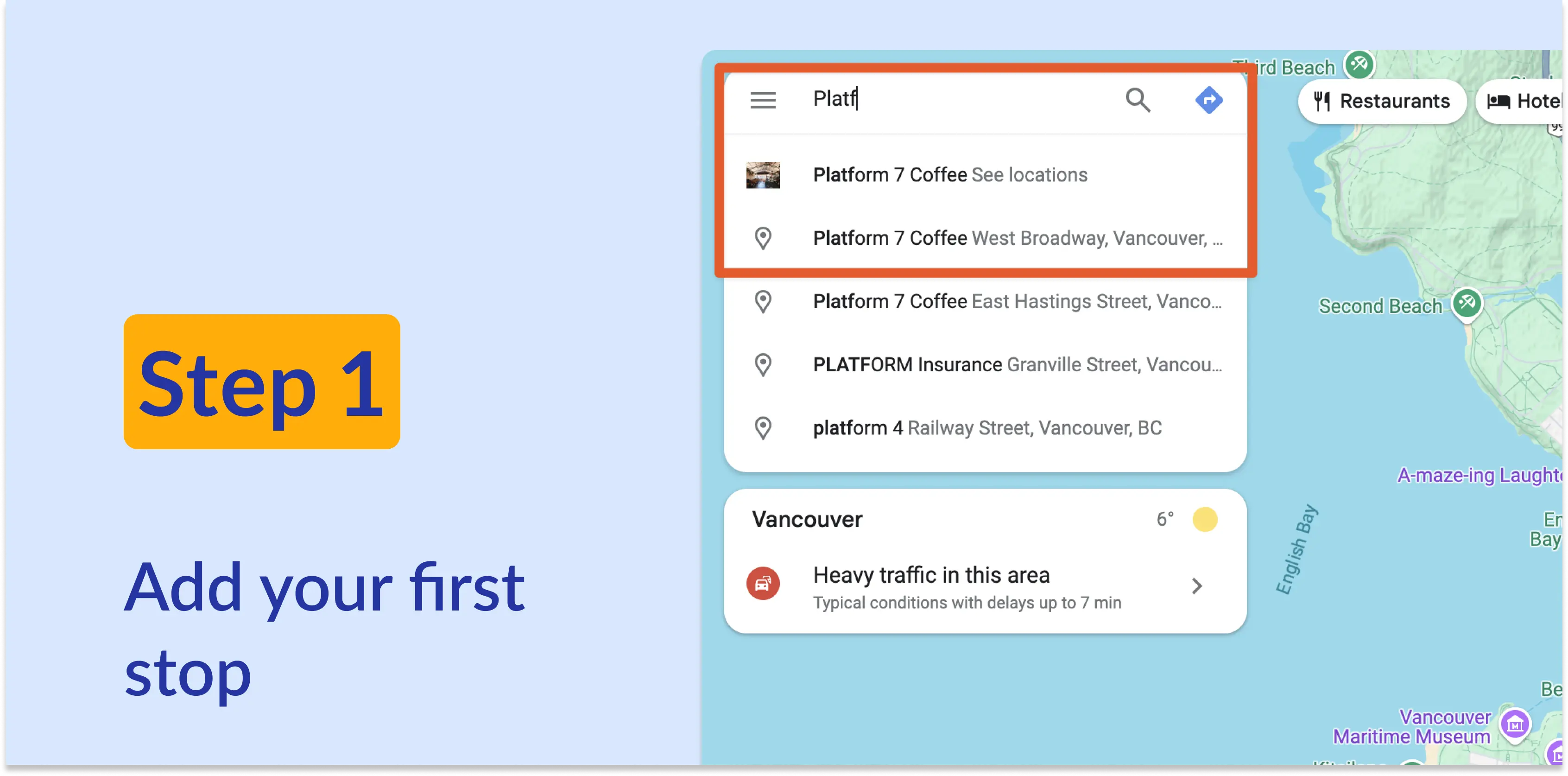
Go to Google Maps and add your first stop. You can use a street address, or just start typing the name of a business or place and Google will find it. (Sometimes there is more than one place with the same name, so double check that Google has picked the right one.)
If you’re planning ahead, it’s a good idea to have the list of all the places you want to go ready in an Excel spreadsheet or Google sheet. That way you can be sure not to miss anything, and you can keep track of exact addresses, place names, and any notes you need to make.
In our example, we’re visiting a bunch of restaurants and coffee shops around Routific’s home town of Vancouver, so we’ll start with one of our local favorites, Platform 7 Coffee. You can also click anywhere on the map to set your first stop.
Google maps on desktop vs mobile
You’ll notice that we’re using the desktop version of Google Maps for this tutorial, not the mobile version. Here’s why: You CAN plan a multi-stop route using the Google Maps app on your iPhone or Android smartphone, but the app wasn’t really designed for working with more than two or three stops at a time. It’s easy to make mistakes, accidentally click the wrong thing, and have to start all over again. On the desktop it’s easier to see your whole route at once, and to move stops around.
The same goes for Apple Maps — the apps are fantastic at giving you the best route from your starting point to your final destination, with turn-by-turn directions that update in response to live traffic conditions. But they can’t really handle juggling multiple stops at the same time.
If you only have your phone, don’t worry — the steps are the same. Just be extra careful not to accidentally click out of your route.
2: Click on Directions to open the route panel

With your first destination set, Google will open a preview panel on the right-hand side of your screen. It might show interior shots of a business, or the Street View image of the address, along with other information.
To open the route panel and start adding addresses, click the “Directions” button.
3: Add a starting address
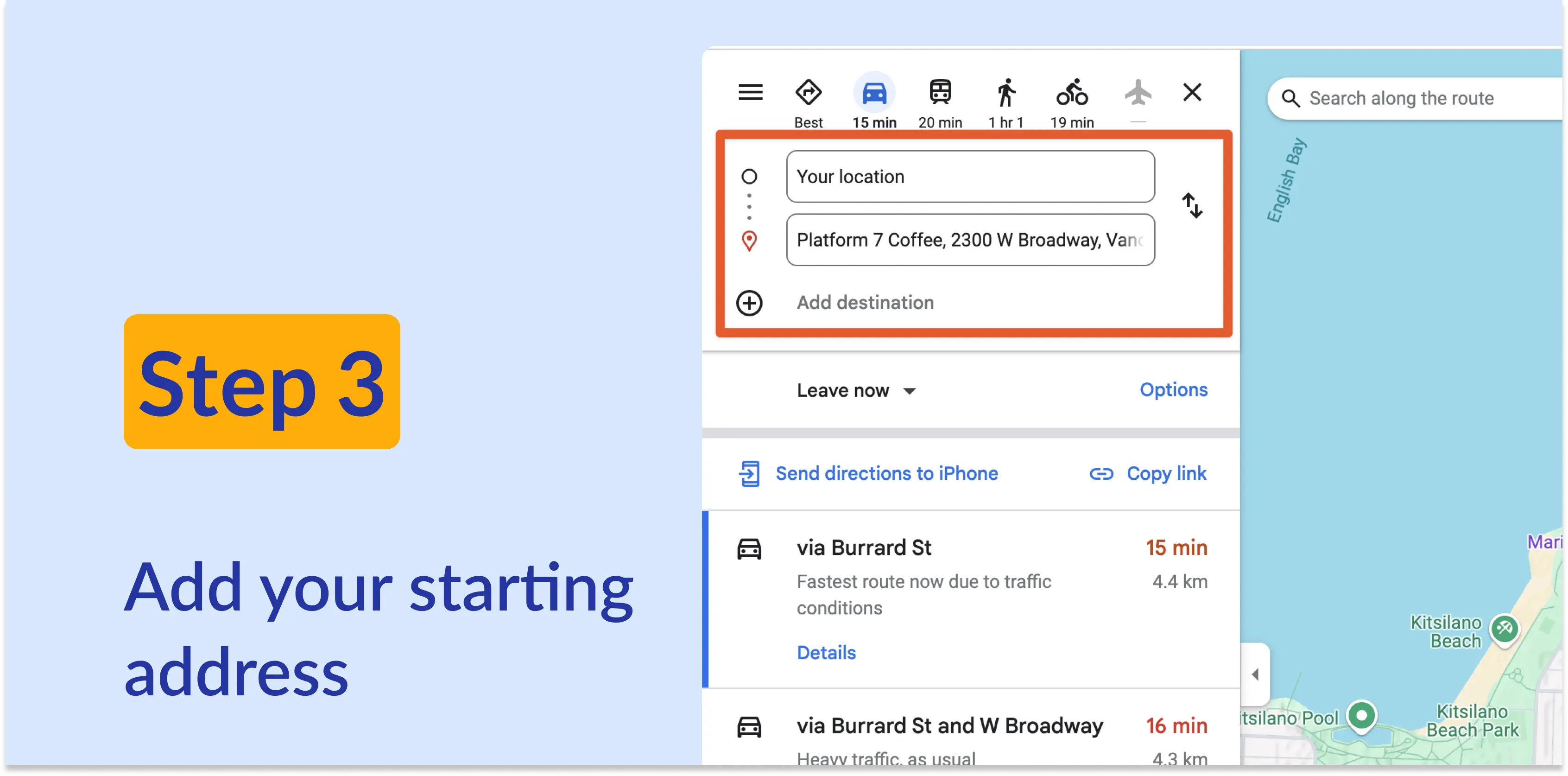
You’ll notice that Google uses this step to set your starting point, rather than your next destination. If your route is going to be starting from your current location, just click in the box to confirm “your location”.
If your route will be starting somewhere else, add that address — and again, Google will automatically create a route between the two places for you.
At this stage, with just two destinations, there’s a very good chance you’ve also got the fastest route. Point to point navigation with estimated travel time and real-time traffic updates is where Google Maps really shines.
4: Add more destinations
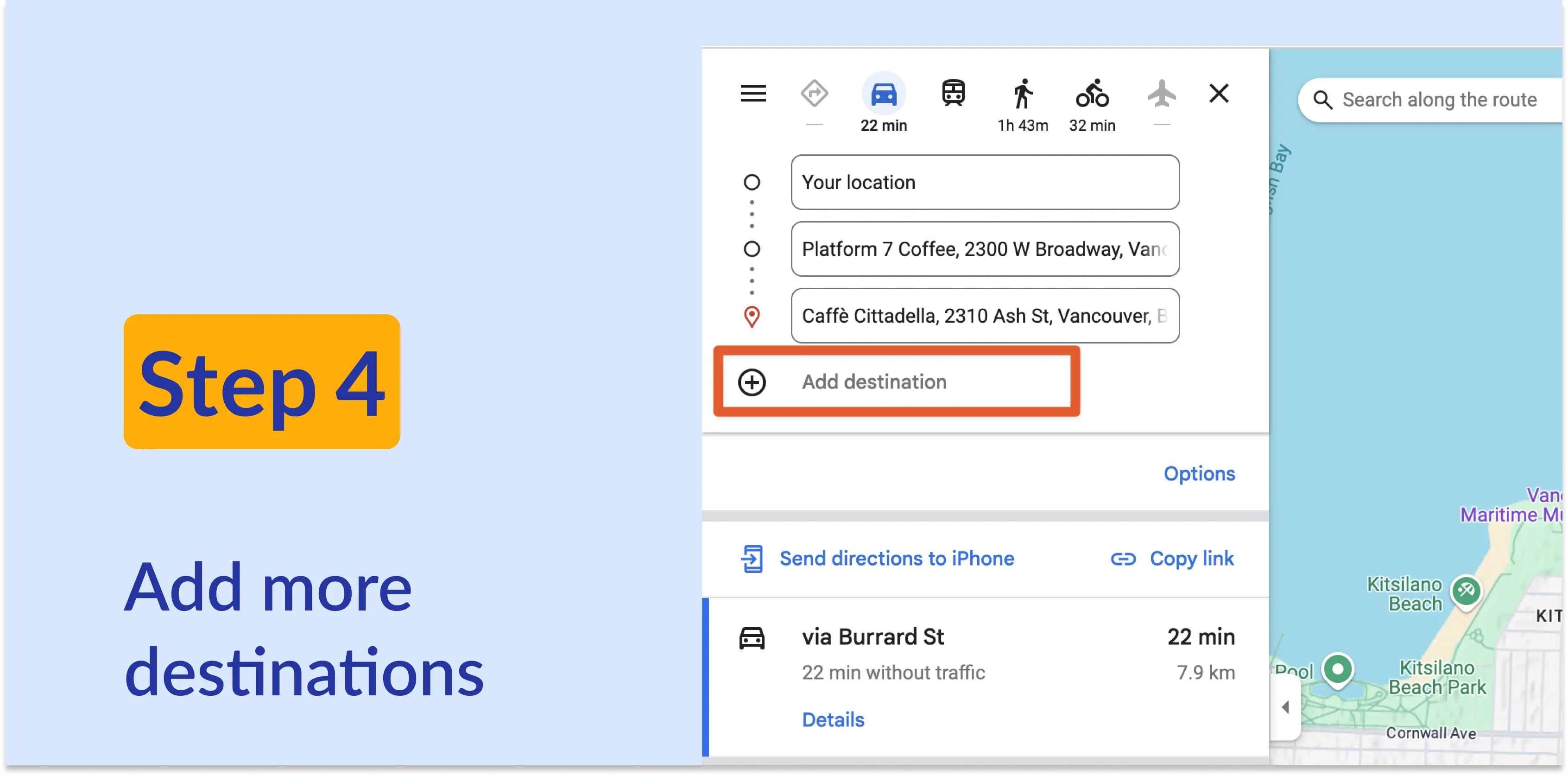
Click on the “Add destination” button. A new box will appear ready for you to enter your next address.
Now is a good time to check that you’ve chosen the right transport mode. If you’re traveling by car, make sure the car icon is highlighted in blue. If you’re planning a walk or bike ride, choose those modes instead. The public transit mode unfortunately doesn’t allow you to add multiple destinations.
5: Keep adding destinations until you hit the limit

Now just keep adding destinations until you’re done, or until you hit the limit of 10 stops.
That’s great, right? You have a route! Except, you may notice the same problem that you can see in our sample route: It looks like a piece of tangled spaghetti. Google kept our addresses in exactly the same order we entered them, which was kind of random. A list of stops is a very different thing from the best route, or the most efficient route.
Google Maps has estimated our total trip length here as 1hr 52 minutes. In the next step, we’ll show you how to create a shorter, more sensible route and cut the total time on the road.
6: Rearrange your stops
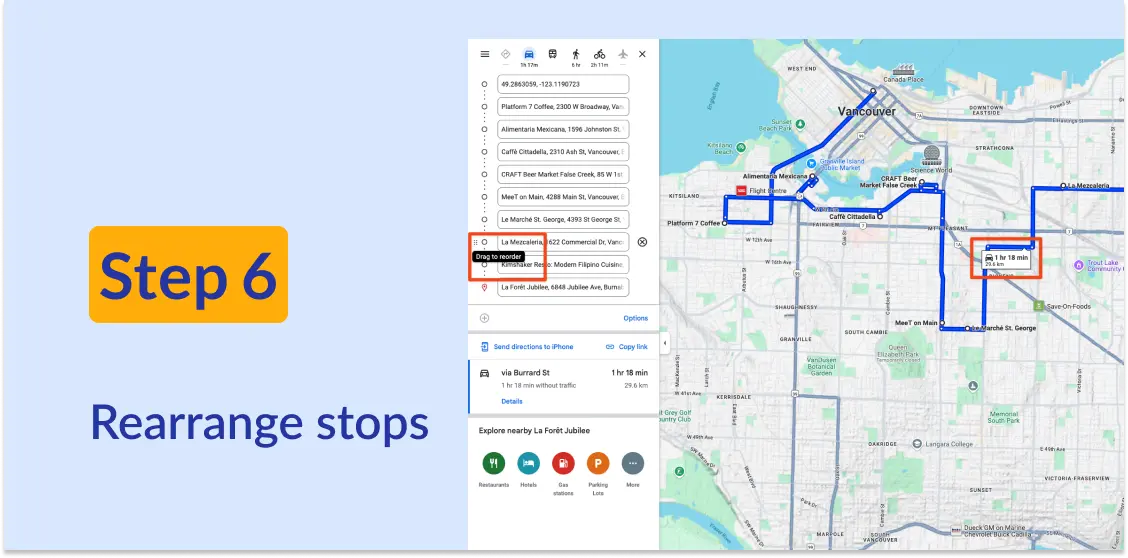
If you hover your mouse over one of your addresses, you’ll see an icon with six dots and a “Drag to reorder” note. Click and hold on the dots to drag any address to a new place in the list.
You can choose any order that makes sense to you — for example, in our sample route we’ve chosen to start with the address furthest to the west, and then finish in the east. You’ll notice that our re-ordered route is a lot simpler. We’ve also managed to cut our journey time: Instead of spending 1hr 52mins on the road, we’re only spending 1hr 18 mins. That’s half an hour saved over just 10 stops!
The difference will be more or less dramatic depending on what order you added your stops. But it’s always worth experimenting with stop order, because you can save a lot of time this way.
7: Share your route
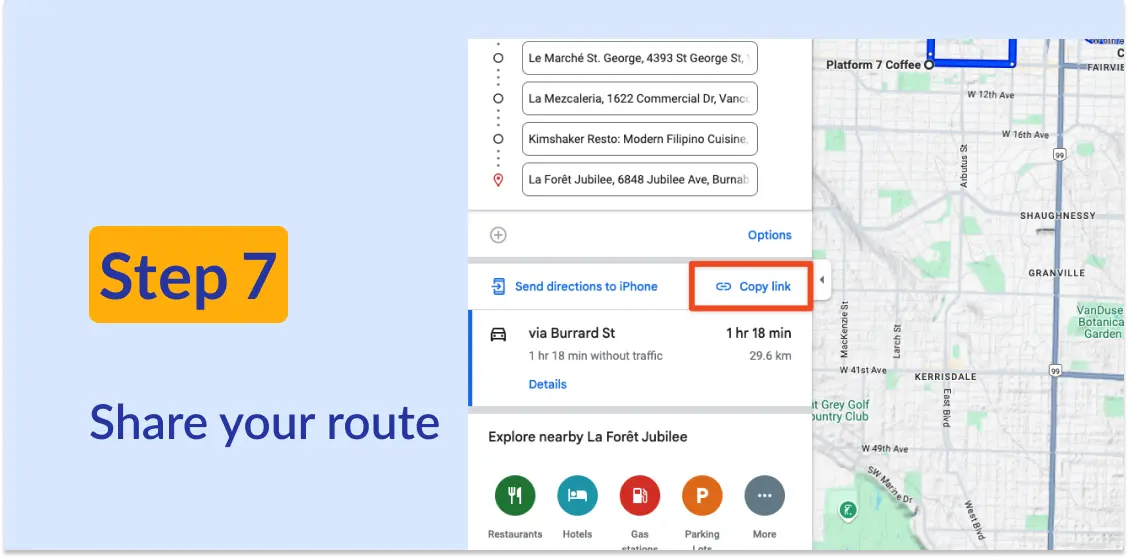
The last step is to get your route on your phone or other mobile device so you can actually drive it.
We like using the “Copy link’ feature for this, for a couple of reasons:
- The “Send directions to phone” link can be unreliable. Maybe it’s iOS and Google not playing nicely together, but for us, clicking that link results in absolutely nothing happening most of the time. Android users may have better luck.
- Using “Copy link” creates a link that you can easily save to use later, or share via email, text message or whatever you like.
8: Open the route on your phone
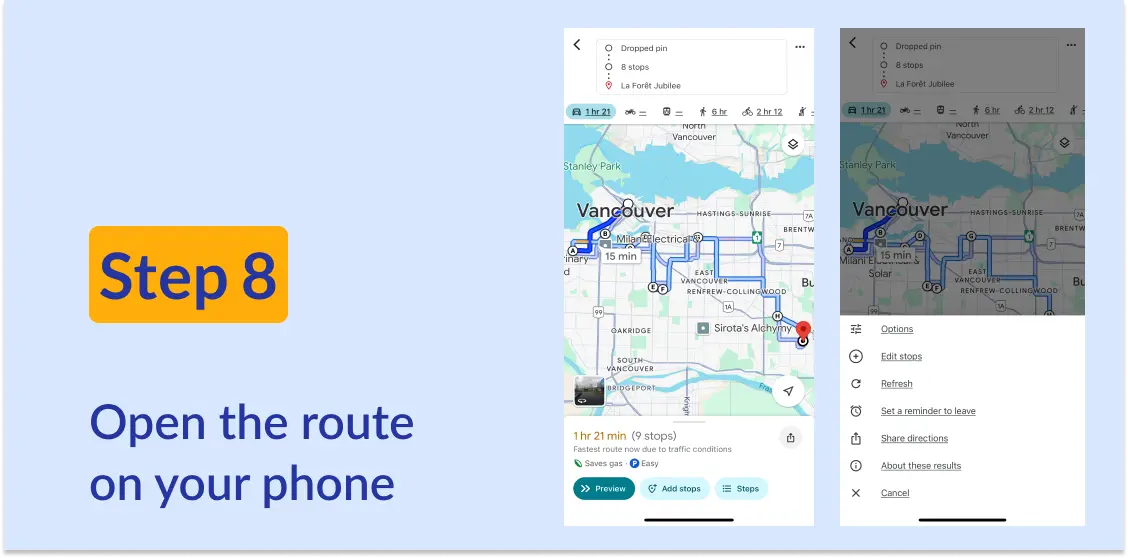
Paste your route link into a browser and you’ll get a prompt to open Google Maps, where your full route will be displayed ready to go.
If you’re already at your starting point, the highlighted button in the bottom corner will say “Start” and you can start your trip anytime. If you’re somewhere else, it will say “Preview” until you’re in position to go.
At this point you can also adjust a number of settings and route options, by clicking the three dots ⋯ “kebab” menu at the top right hand corner of your screen. We like “Set a reminder to leave”. If you click “Options”, you can choose navigation preferences like avoiding tolls, highways, or ferries.
B: How to get up to 25 stops in Google Maps
You can’t add more than 10 stops directly in Google Maps, but there’s a workaround: you can combine multiple Google Maps pages to get up to 25 stops.
The free tool MoreThan10 is the easiest way to do this:
- In Google Maps, add destinations until you hit the 10-stop limit.
- Open a second Google Maps tab and add your next 10 stops.
- If necessary, open a third tab for the last 5 stops.
- Copy and paste the URLs for each page into MoreThan10 and click Submit.
- Open the resulting URL to get your 25 stops in Google Maps.
That’s all it takes! You will still need to drag and drop your stops around to get a decent route, but you can get a longer route plan.
💡Tired of manually reordering stops? Routific automatically finds the most efficient route in seconds. Start your free trial now — no credit card needed.
C: Use Routific’s Chrome Extension for Google Maps to plan multi-stop routes
If you use Google’s Chrome browser, Routific’s free extension is an even easier way to turn Google Maps into a route planner. Here’s how to do it:
- Go to the Chrome Web Store and add the extension. Then open Google Maps and click “Continue with Google’ to connect your account so that Routific’s routing algorithm can read your map info and suggest a new route. You’ll only need to do this once.

- Click “Take me there” to open a new Google Maps tab and start adding stops.
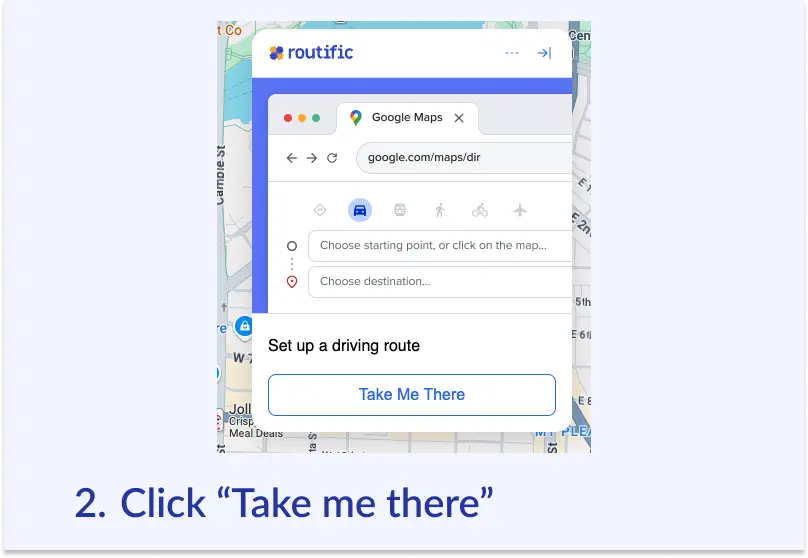
- Once you’ve added stops, click to optimize and wait a few seconds while the algorithm does its job.
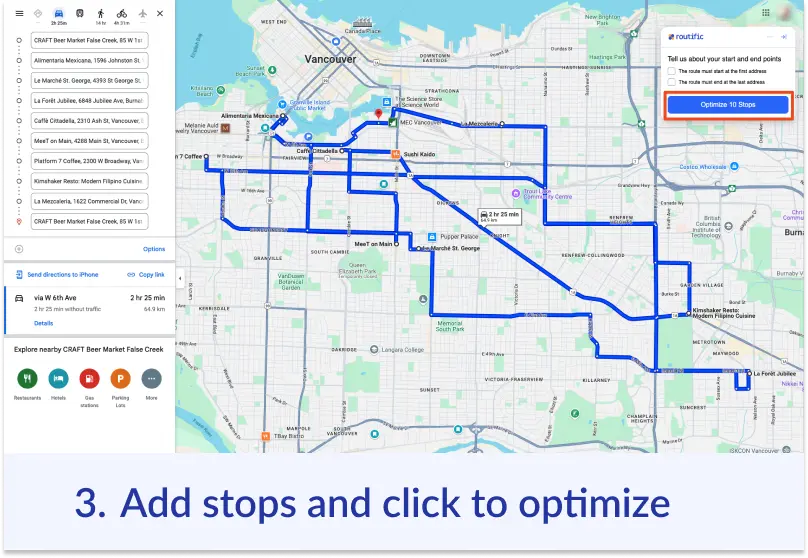
4. That’s all! You can share your optimized route in the same way as any other route you’re created. To hide the Routific panel, just click →| to move it to the side.
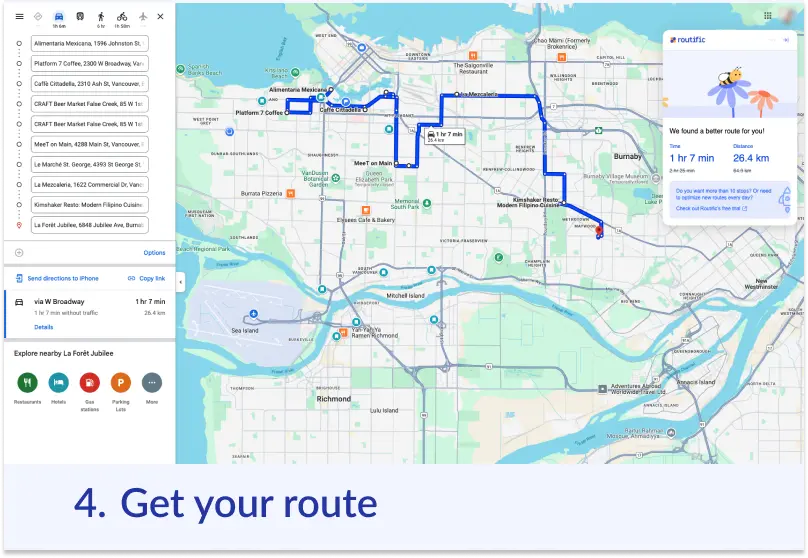
That’s two ways to create and optimize multi-stop routes in Google Maps. But what if you want more than just driving directions — say you’re planning a road trip and want to save places to visit, or you want to create a shareable map of your favourite coffee spots? That’s where it’s good to know about Google’s My Maps.
💡Need more than just route optimization? Get proof of delivery, customer notifications, and driver tracking with Routific's complete delivery management software. Try it free for 7 days.
D: How to plan multi-stop routes with Google’s My Maps
Google’s My Maps is an interesting alternative to Google Maps route planning — although it’s more of a general mapping tool than a route planner. It’s a great option for saving places you want to visit, or for creating and sharing public maps. For example, here’s a map of places participating in the 2025 Vancouver Hot Chocolate Festival, one of the favourite winter events in our Canadian hometown. It’s a great example of using a map to share topical information.
One of the best features is that when you pin a location on My Maps, you can add extra information like notes, custom icons, and colors.
The disadvantages are that My Maps is not great at actual route planning, and you definitely won't get optimized routes. You also still have to work in groups of 10 locations at a time, and it doesn’t give live driving directions. But it’s still worth knowing how to do it! These are the steps to follow:
1: Open My Maps and create a new map
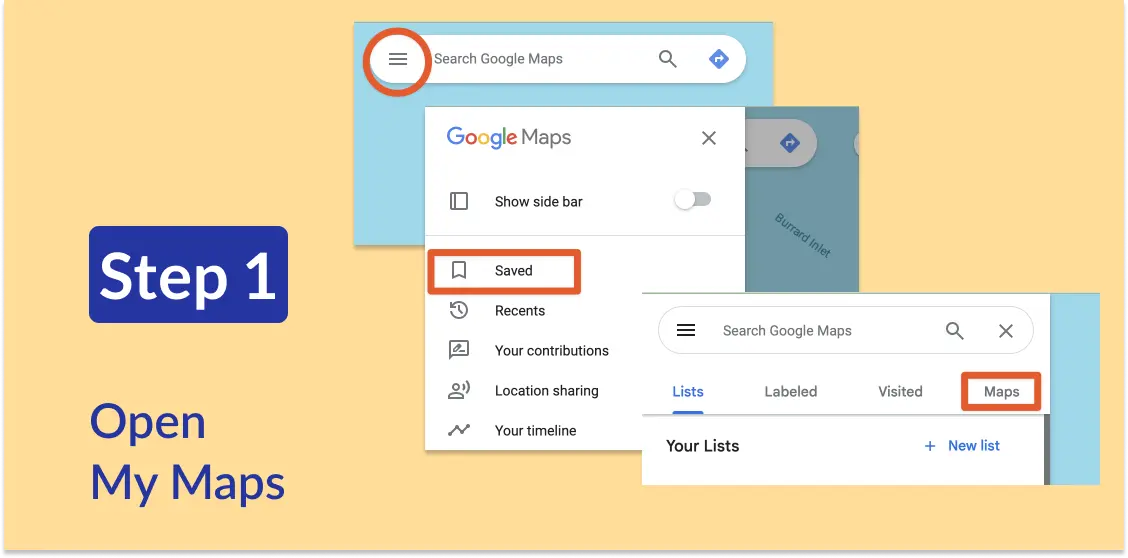
There are two ways to open My Maps:
- Go directly to mymaps.google.com.
- Connect from Google Maps: Clicking on the ‘hamburger’ menu icon ☰, then Saved > Maps.
On the main page you’ll see a bright red “Create a new map” button, and a list of maps you’ve created or visited.
2: Add places
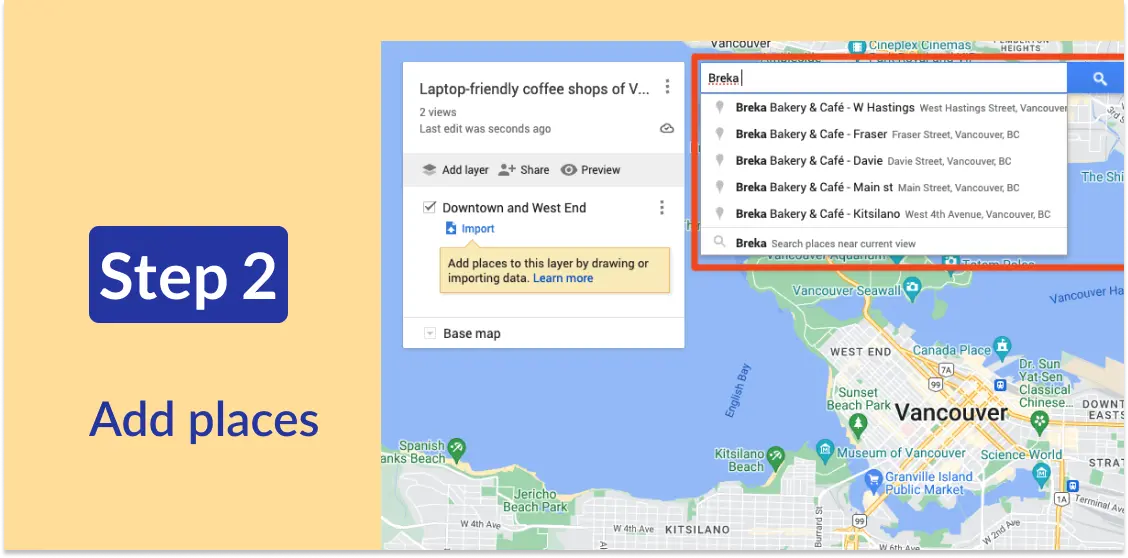
Once you have your map set up, just click in the search bar, start typing the name of the place you want, and select it from the pop-up list to add it to your map. You can also click on any existing place on the map to add it to your personal map.
You can add up to 2,000 separate places to each map you create in My Maps.
3: Customize your map

My Maps has some really great functionality for customizing your maps to suit your needs. You can add icons, colour codes, and notes, and even change place names if you want.
To add extra information to a place, just click on it and then on one of the icons along the bottom.
Here’s the result: A map clearly showing the locations of our favourite coffee places around Vancouver.
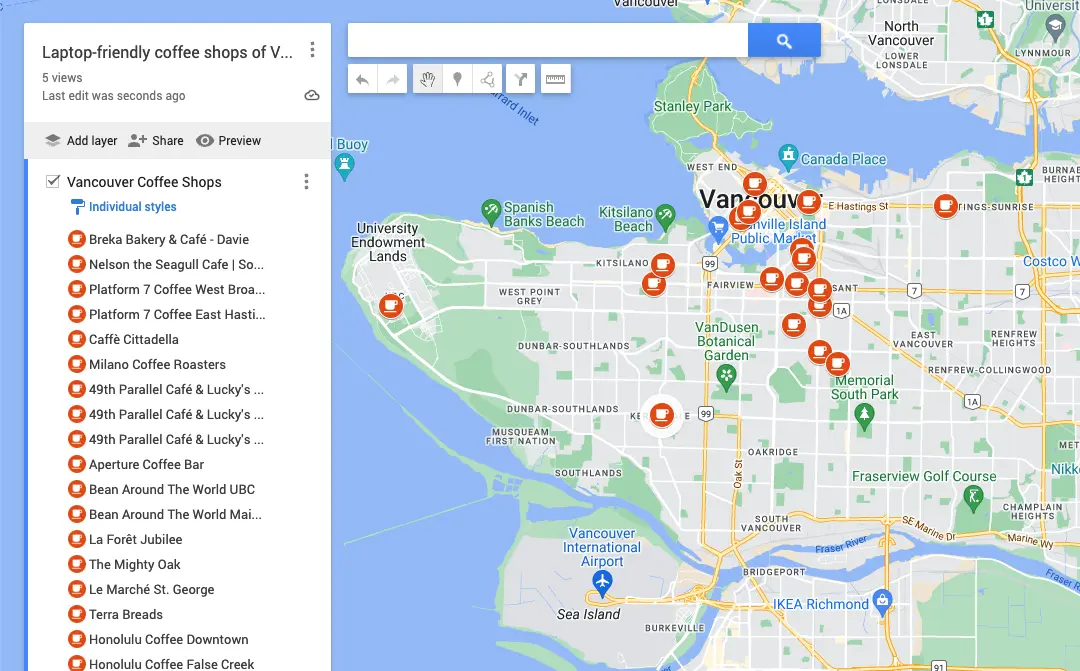
You can showcase pretty much anything you want with this tool — your favourite sushi places, kids’ playgrounds, music venues, graffiti, Halloween displays, gardens — your imagination is the only limit!
Note: My Maps is organised using layers, which appear as lists in the right-hand panel. So far, we have just one layer showing coffee shops. You can add multiple layers and use them however you want – for example, you could add a layer for different kinds of place, so the next one might be bakeries. Or you could group your places into layers according to what part of town they’re in. There could be a layer for downtown, one for the east side, and so on.
4: Start drawing a route
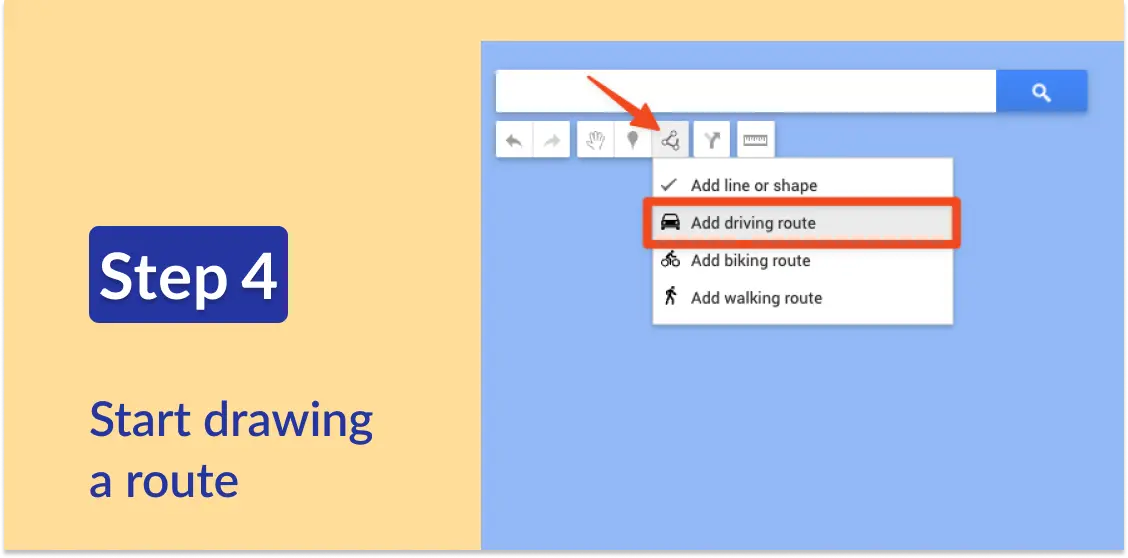
Now it’s time to plan some routes! Start by clicking the “Draw a line” icon at the top right under the search bar, and then “Add driving route”. Click your starting point on the map, then the next place you want to visit, and voila! Your route will appear on the map. (You’ll see you also have options to choose a different mode of transportation like walking or biking.)
At the same time, a new layer with your driving directions will appear in the right-hand panel. To add new places to your list, just keep clicking “Add Destination” and then the next place on your route. Here’s how it will look:

You can add up to ten places to each driving directions layer. When you run out of space in one layer, you can just start another. In our sample map, we ended with two route layers with ten places each. Here’s how it looks:
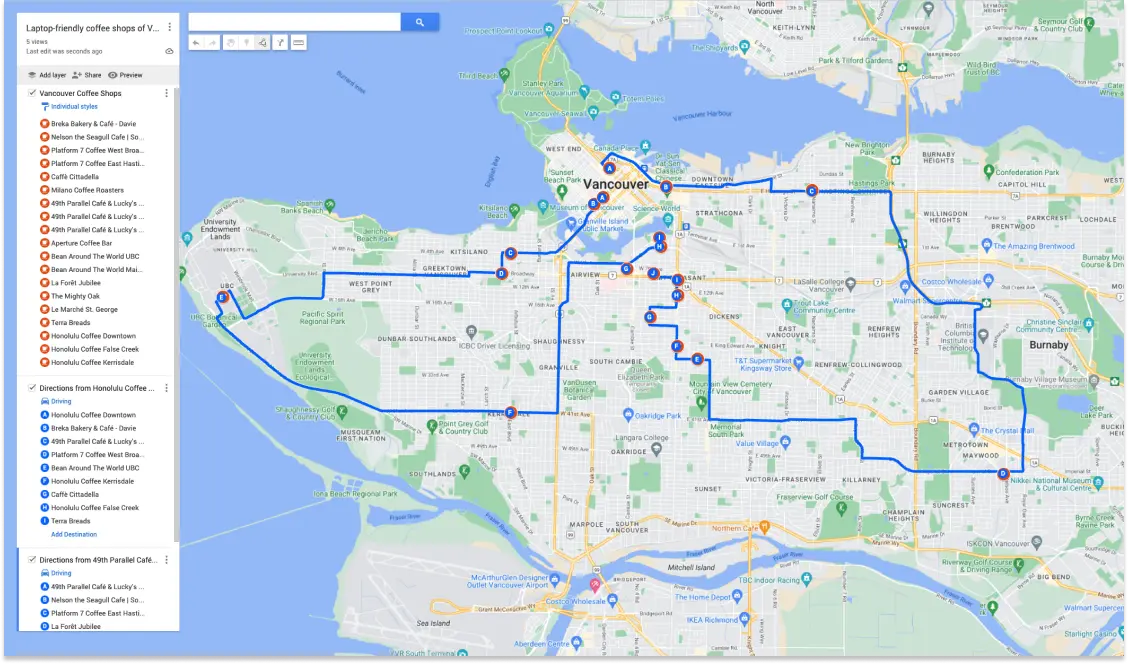
5: View route details
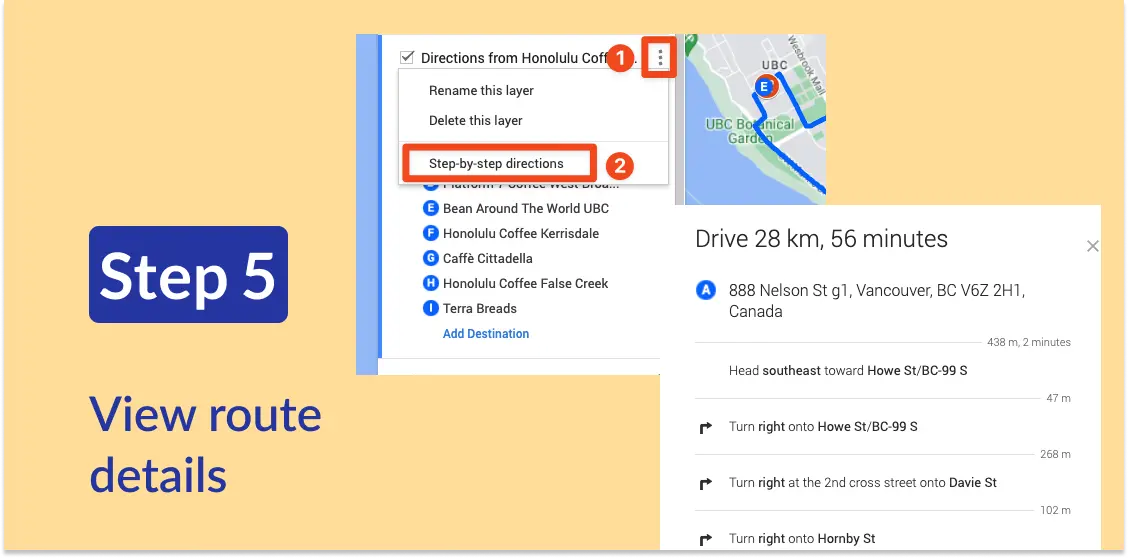
Unlike Google Maps, My Maps doesn’t display time and distance information right on the route. To see this, click the three dots next to your layer name and choose “Step-by-step directions”. That will pop up a detailed breakdown of your route, with a time and distance estimate at the top.
If things start getting complicated, you can hide or show layers using the checkboxes next to their names.
There’s no need to save these routes, by the way — they've been saved automatically, and you can come back to your map anytime. Your maps are also accessible from Google Drive.
6: Share your map
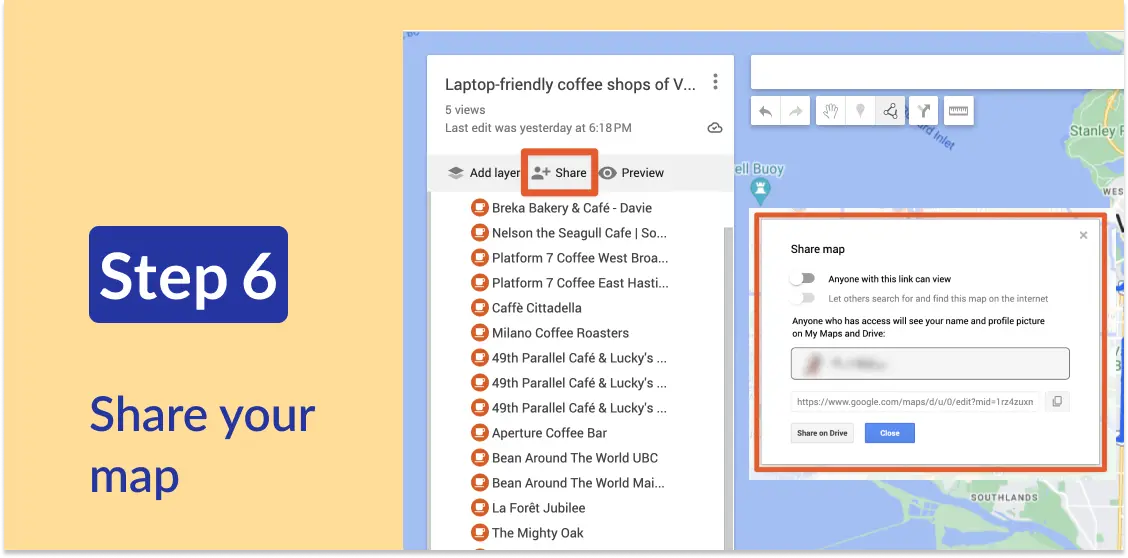
Sharing your map is easy. Once you’ve set up all your places, just click on “Share”, choose the level of sharing you want and copy the resulting URL. “Anyone with this link can view” is the easiest (but don’t put sensitive information on this map!)
Now you can share the map with anyone via email, text or a Google Drive link.
7: View your map on your phone
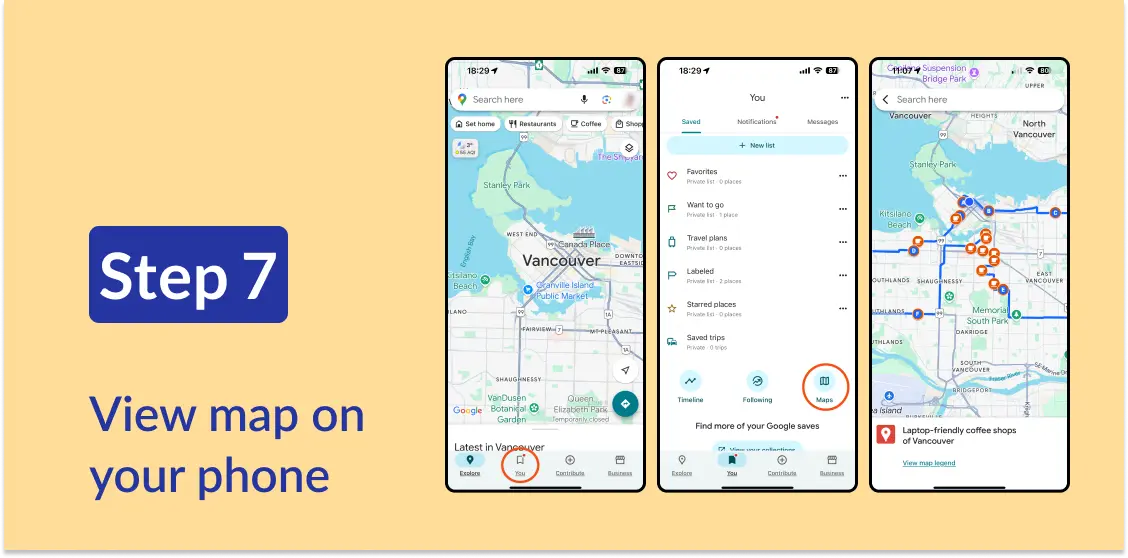
To use the map on your own phone, just open Google Maps and click on “You” at the bottom of your screen. Now click on “Maps”, and you’ll see a list of all the maps you’ve created. Click on the one you want, and you’ll see all your saved stops and routes.
Actually driving a route is a little trickier because My Maps doesn’t handle directions in the same way as Google Maps. So we’ll tackle that in the next step.
8: Navigate your route
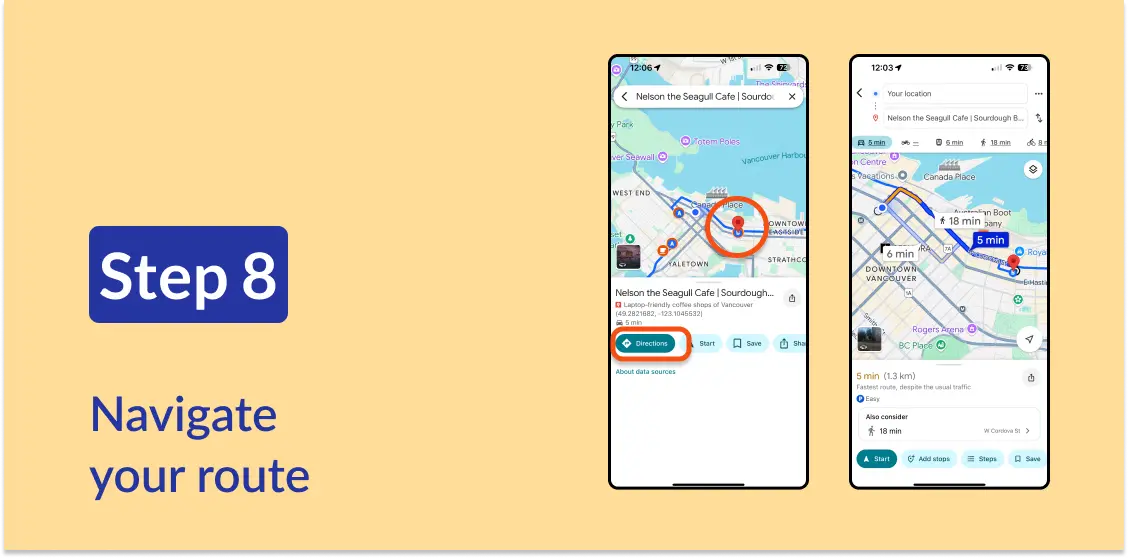
With My Maps you can’t just open a route and start navigating in the same way you’d use a Google Maps route on their mobile app. To get actual driving directions for your route:
- When you get to your starting point, open your map following the instructions in Step 7, and click on the first place you want to visit.
- Now click Directions — and your route will be mapped out for you with all the usual Google Maps features.
- When you’re ready to move on to the next stop, open your map again, click on your next destination, and click Directions. Do the same for every stop.
If you accidentally click away or lose the map, just re-open it using the same steps. The map is saved, so you won’t lose anything.
And that’s how to use Google My Maps to create a multi-stop route! As you can see it’s very useful for a relatively small number of stops, but once you start getting to 10+ stops and multiple layers, things can get complicated.
Alternatives to Google Maps route planner
If you need to plan multi-stop routes often, you can save a lot of time and effort by using a proper route planner.
There are even free route planners available — they are limited in functionality, but definitely a step up from Google maps route planning. We recommend:
- Soloroute.app: This is a new, very basic route planner, but it’s quick and easy to plan and optimize a route of up to 25 stops. You can open the resulting route directly in Google Maps for driving.
- RouteXL: You can plan a route of up to 20 stops free, and there are paid options if you need more.
Check out our full list of free route planners for more.
If you are creating delivery routes and need to plan multiple routes every day, along with extra features like proof of delivery and customer notifications, try a free trial of Routific.
Summary: What Google Maps does best, and where it fails
Things Google Maps is great at:
- Finding you the best route from A to B, and maybe C.
- Turn by turn directions.
- Planning routes that help you avoid tolls or bridges.
- Re-routing according to live traffic information.
- Giving detailed information about your destination, like opening hours and contact details.
- Giving options for walking, biking, and using public transport.
Things Google Maps is not so great at
- Planning a route with more than five or so stops is awkward.
- It can’t automatically optimize your route.
Frequently Asked Questions
Is there an app for mapping a route?
With Google Maps you can map a route with up to 10 stops for free. If you need a longer route or have specific needs — for example if you want to map a hiking, running or cycling route, a delivery route or a trucking route, you will probably need a more specialized app.
Can I plan a route with unlimited stops in Google Maps?
The longest route you can plan in Google Maps is 10 stops. If you need a larger number of stops, your best bet is to use a free trial of a route planning app like Routific, which has a limit of 4,000-5,000 stops.
What is Google route planner?
Google route planner is the route planning feature built into Google Maps. It's the same thing as "Google Maps route planner" — both terms refer to Google's free tool for creating multi-stop routes with up to 10 destinations. You access it by opening Google Maps and clicking "Directions," then adding multiple stops to create your route.
Can Google Maps do route planning?
You can plan a route of up to 10 stops in Google Maps. It's a good, free choice for short driving, biking or walking routes. You can work in batches to plan longer routes. If you’re a delivery business or delivery driver, our recommended method for longer routes is laid out in our Google Maps Route Planner for Deliveries post.
How do I plan a route with multiple stops for free?
Google Maps is a great choice if you need to create a route with multiple stops for free. You can plan up to 10 stops at a time. For longer routes, use Google’s My Maps tool, or an alternative like MapQuest, MyRouteOnline, or RouteXL. The RAC Route Planner is a good choice for those based in the UK.
Related articles
Liked this article? See below for more recommended reading!
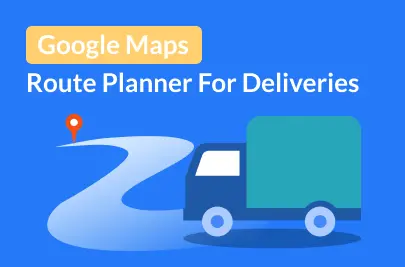
How To Use Google Maps Route Planner For Deliveries

How To Plan Delivery Routes With Excel (With FREE Template)
